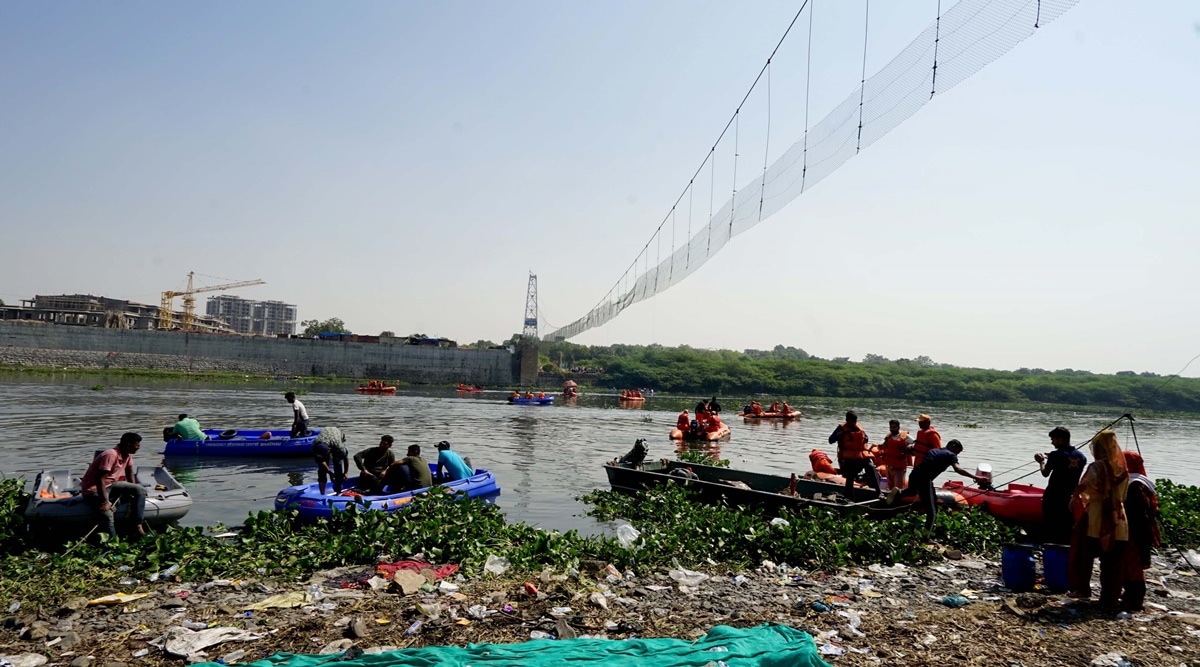 While many people have been killed in crowded situations in India during mass gatherings, Morbi cannot per se be called a typical crowd disaster -- it was caused by structural failure and management apathy. (Express photo by Bhupendra Rana)
While many people have been killed in crowded situations in India during mass gatherings, Morbi cannot per se be called a typical crowd disaster -- it was caused by structural failure and management apathy. (Express photo by Bhupendra Rana)Written by Kulwant K Sarangal
The recent tragedies in Seoul, South Korea, and Morbi in Gujarat have once again put crowds and their management under the spotlight. While many people have been killed in crowded situations in India during mass gatherings, Morbi cannot per se be called a typical crowd disaster — it was caused by structural failure and management apathy. Nonetheless, crowd management continues to pose challenges to the regulatory and other agencies in India and around the world.
Accidents during mass gatherings are not a novel phenomenon. The Kumbh Mela is an ancient festival that attracts millions of pilgrims. On April 11, 1820, the members of the Sunvassees and Byragees (sects of Sadhus) vied with each other for the honour of being the first to bathe in the Ganga at Haridwar. As they rushed in, the multitude and unfortunate sepoys were carried down with such violence that they got jammed together within three steps of the water. This incident happened at Har Ki Pauri, which was a steep descent and about 10 feet broad, with high walls on one side but within three steps of the water. At the summit on the side facing the town, there was a broad flight of steps at the top of which the guards were stationed to prevent the crowds from pressing indiscriminately. But the sudden rush left people crammed together. The number of deaths reported was 430.
A vivid description of the tragedy, recorded in the Asiatic Intelligence Report, is a classic study of “crowd crush”. It was not a stampede as people often call it. By the time of the Kumbh Mela in 1832, Lord Amherst’s government widened the said ghat to prevent further incidents of this nature.
The Seoul crowd tragedy was also a classic case of crowd crush or collapse, though the media has casually reported it as a stampede. The Morbi tragedy is a failure in managing the access to the bridge, which should have been restricted to its prescribed capacity after certifying its structural integrity. This was not a case of crowd crush or crowd collapse, though people on the bridge were reportedly swaying and swinging, which may be one of the contributing factors to the accident.
Utter disregard for the size of the crowd likely to descend in a given space at a given time leads to crowding accidents. When the crowd crush happened in 1820 in Haridwar, Lord Amherst widened the ghat, and tried to provide more space for the devotees to pass through to take the holy bath. Manoeuvring time is a constraint in some gatherings such as religious gatherings as rituals must be performed within the auspicious time frame. So, time and space management helps in keeping the crowd flow below the critical density. Crowd management scientists have worked out the levels of service for crowds at different venues, which should be adhered to by the event organisers to avoid critical densities.
Crowd movements involve a combination of voluntary and involuntary forces. Critical crowd density makes crowd movements involuntary whereas optimal density guided by the level of service helps the crowd to self-organise voluntarily. Dirk Helbing and his team of mathematicians have tried to explain crowd dynamics with the help of forces produced by the crowd – both physical and social. So long as crowd density is managed at an optimal level, people in crowds are governed by social force, a voluntary force, which is a physical response to a social interaction.
However, if the crowd density reaches a critical level, people’s movements within it are governed by involuntary forces — that is, the physical forces that are produced by pushing each other from behind or from the sides and so on in a packed-together situation. If the crowd flow continues unabated, people keep filling every available space between themselves and eventually they start suffocating and even dying while standing. Women and children – on average shorter than men — become the first casualties. Death may occur within three to four minutes once people are compressed by the crowd. To avoid crowd disasters, density must be kept to a level that allows people to move voluntarily with the flow.
Why is the simple science behind crowd management not applied by law enforcement agencies? First, policemen are trained to control the crowds and not manage them. The control template aims at restricting or limiting group behaviour. The essence of crowd control is the use of measures to enforce order. Crowd management has now emerged as a discipline that requires a planned response to mass gatherings and enhancing the experience of those participating in them. This requires crowd planning to be prioritised for public safety. The design of venues, streets and capacities of ingress and egress points should guide crowd planning and contingency plans such as evacuation plans and trauma management services must be kept nearby to respond to any emergency.
With the help of effective communication with the crowd, entry and exit to the venue can be constantly monitored to manage the density and avoid tragedies.
The writer is Additional DGP, Traffic & Law and order, Mumbai. He planned the Nashik Kumbh Mela 2015. Views are personal